#1950's bicycle ad
Photo

“Oh damn! I brought the box without the reefer inside"
Ladies' Home Journal October 1955
#vintage ads#vintage ad#advertising#advertisment#1955#playing cards#cards#party#1950s#1950's ad#1950's#1950s ad#funny#humor#humour#bicycle
21 notes
·
View notes
Text
Monark silver king bicycle

MONARK SILVER KING BICYCLE PLUS
MONARK SILVER KING BICYCLE SERIES
MONARK SILVER KING BICYCLE FREE
One of our crew replaced the switch and it is now run on a four AA battery pack that is attached via velcro in the tank. The bulbs are burned out but the light does work. The peddles work and are in ok shape we did not replace them since they are original.
MONARK SILVER KING BICYCLE SERIES
These were part of a series bikes they named and fashioned after popular cars of the era from what we have been told.
MONARK SILVER KING BICYCLE FREE
Please feel free to contact us anytime by going to the contact seller section of the listing. We are not experts in any particular field we will try to describe to the best of our abilities- but we are human and occassionally make mistakes- please contact us as soon as possible so we can remedy any errors. Estate and garage sales, as such the item may have some signs of use or flaws. Most of our items are purchased at auctions. We prefer to ship priority mail onlyif you choose First class as your option we do not have the option of adding tracking or insurance to your parcel. We will always combine shipping on multiple purchases. Within 24 Hours of purchase date is preferred. more NUMBER AS PICTURED* EACH BOX CONTAINS 8 individually boxed spark plugs* as found no returns Pictures are part of our description please review them and let us know if you have any questions prior to purchase or bidding.
MONARK SILVER KING BICYCLE PLUS
new old stock* 1 box* Champion Copper Plus spark plugs* MODEL STOCK. Please let us know how we can better serve you. $4.00 Media Rate(1-2 week delivery) or $7.00 USPS Priority Mail(3-5 day delivery) shipping in the USA. This is a must have book for any bicycle collectors library. Flyer, Rover, Brownie, Speed Bike, Auto Coaster Irish Mails, Biplane Flyer, Silver Ring, DeLuxe Flyer, Hi-Lo, Tandems, Aristocrat, Commander, Motor Bikes, Cadet tricycle, Imperial, Vogue, Scooters, Racer, Seiberling, Goodyear, Featherweight, Roadster, Racer, Cushioner, Double Eagle Clipper, Firestone, Firebird, Olympic, Evans, Interceptor, Sonic Scout, Cutlass, Sky King, Viscount and even the infamous Mickey Mouse tricycle. Every page has been scanned from original ads and catalogs. 9 color pages with 42 photographs and color catalog examples of Colson bikes. Newly revised expanded edition with 120 pages covering bicycles and tricycles from 1928-1961. more A compilation of catalogs and ads from The Colson Corporation, Elyria Ohio. Silver King also developed a monthly payment plan, making their purchase a bit more palatable for depression era consumers on a tight budget.NEW BOOK antique COLSON old Bicycle Collectors REVISED EDITION! prewar postwar Here's a wonderful book by John Polizzi. Their unique style and light weight made them extremely appealing. Monark began building aluminum bicycles under the name Silver King in the 1930s and continued their production into the 1950s. The designers must have had fun going from batteries to bicycles. Lights, head tubes, rear stays, bottom brackets. There are quite a few art deco touches on all of the aluminum models from Monark Silver King. Monark was a unique company that had its start as a battery manufacturer from the early part of the century. This bicycle has the triple step lobdel rims, round shaped stainless fenders, and the straight steel truss rods. Year is most likely late 1930's or early 1940's. Very cool bike and with a little (alot) tlc and elbow grease would make for a great project bike. The bike is rideable but will require a complete overhaul of the drive train to get back to fully operational. Tires hold air but aren't even close to original - both built overseas. The fenders have several dings and dents, and they do not have the front and rear lamps/accent pieces. Wheels, frame, fork, fenders, and dropcenter stand are the only likely original pieces left. Aesthetically the frame is in pretty good condition and has a nice patina (ok, lots of patina) from over the years - fun to polish up and make it mirror shiny. Aluminum tubing constructed using "mushroomed" tubes and chromed steel fork blades with no suspension. This a Vintage 1930's or 1940's Monark Silver king built Wards Hawthorne aluminum mens bicycle.

1 note
·
View note
Photo
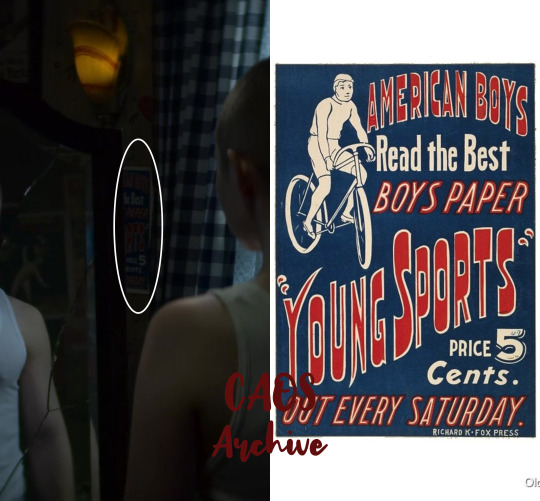
Where: Putnam Home (Theo’s Room)
When: Season 2 Episode 4 (Doctor Cerebus’s House Of Horror)
What: 1950's Bicycle Ad - Prices Vary
#caos#caos archive#Chilling Adventures of Sabrina#putnam home#theo's room#season 2#s2e2#doctor cerebus's house of horror#1950's bicycle ad#bicycle ad#1950's#1950s#ad#bicycle#exact#wall art#wall decor#decor#poster#theos room
0 notes
Text
Planned obsolescence
Planned obsolescence, or built-in obsolescence, in industrial design and economics is a policy of planning or designing a product with an artificially limited useful life, so that it becomes obsolete (i.e., unfashionable, or no longer functional) after a certain period of time. The rationale behind this strategy is to generate long-term sales volume by reducing the time between repeat purchases (referred to as "shortening the replacement cycle").
Producers that pursue this strategy believe that the additional sales revenue it creates more than offsets the additional costs of research and development, and offsets the opportunity costs of repurposing an existing product line. In a competitive industry, this is a risky policy, because consumers may decide to buy from competitors instead if they notice the strategy.
Planned obsolescence tends to work best when a producer has at least an oligopoly. Before introducing a planned obsolescence, the producer has to know that the consumer is at least somewhat likely to buy a replacement from them. In these cases of planned obsolescence, there is an information asymmetry between the producer, who knows how long the product was designed to last, and the consumer, who does not. When a market becomes more competitive, product lifespans tend to increase
History and origins of the phrase
The 1923 Chevrolet is cited as one of the earliest examples of annual facelifts in the car industry, because it had a restyled body covering what essentially was nine-year-old technology.
In the United States, automotive design reached a turning point in 1924 when the American national automobile market began reaching saturation. To maintain unit sales, General Motors head Alfred P. Sloan Jr. suggested annual model-year design changes to convince car owners that they needed to buy a new replacement each year, an idea borrowed from the bicycle industry, though the concept is often misattributed to Sloan. Critics called his strategy "planned obsolescence". Sloan preferred the term "dynamic obsolescence".
This strategy had far-reaching effects on the auto business, the field of product design, and eventually the American economy. The smaller players could not maintain the pace and expense of yearly re-styling. Henry Ford did not like the constant stream of model-year changes because he clung to an engineer's notions of simplicity, economies of scale, and design integrity. GM surpassed Ford's sales in 1931 and became the dominant company in the industry thereafter. The frequent design changes also made it necessary to use a body-on-frame rather than the lighter, but less easy to modify, unibody design used by most European automakers.
The origins of phrase planned obsolescence go back at least as far as 1932 with Bernard London's pamphlet Ending the Depression Through Planned Obsolescence. The essence of London's plan would have the government impose a legal obsolescence on consumer articles, to stimulate and perpetuate consumption. However, the phrase was first popularized in 1954 by Brooks Stevens, an American industrial designer. Stevens was due to give a talk at an advertising conference in Minneapolis in 1954. Without giving it much thought, he used the term as the title of his talk. From that point on, "planned obsolescence" became Stevens' catchphrase. By his definition, planned obsolescence was "Instilling in the buyer the desire to own something a little newer, a little better, a little sooner than is necessary."
The phrase was quickly taken up by others, but Stevens' definition was challenged. By the late 1950s, planned obsolescence had become a commonly used term for products designed to break easily or to quickly go out of style. In fact, the concept was so widely recognized that in 1959 Volkswagen mocked it in an advertising campaign. While acknowledging the widespread use of planned obsolescence among automobile manufacturers, Volkswagen pitched itself as an alternative. "We do not believe in planned obsolescence", the ads suggested. "We don't change a car for the sake of change." In the famous Volkswagen advertising campaign by Doyle Dane Bernbach, one advert showed an almost blank page with the strapline "No point in showing the 1962 Volkswagen, it still looks the same".
In 1960, cultural critic Vance Packard published The Waste Makers, promoted as an exposé of "the systematic attempt of business to make us wasteful, debt-ridden, permanently discontented individuals". Packard divided planned obsolescence into two sub categories:
obsolescence of desirability; and
obsolescence of function.
"Obsolescence of desirability", a.k.a. "psychological obsolescence", referred to marketers' attempts to wear out a product in the owner's mind. Packard quoted industrial designer George Nelson, who wrote: "Design... is an attempt to make a contribution through change. When no contribution is made or can be made, the only process available for giving the illusion of change is 'styling!'"
2 notes
·
View notes
Text
What exactly is a grinder for grinding tools
Die grinder is often found in real life, I believe many people do not know what it actually does and what it does, now let's look at it together.
History of grinding machines.
In the 1830s, grinding machines using natural abrasive wheels were developed in England, Germany and the United States respectively to accommodate the processing of hardened parts of clocks, bicycles, sewing machines and firearms. These grinders were made by adding grinding heads to ready-made machine tools such as lathes and planers, which were simple in structure, low in rigidity, prone to vibration during grinding, and required a high degree of skill on the part of the operator to grind a precise workpiece. It had a workpiece headstock and tailstock mounted on a reciprocating table, a box-shaped bed to improve machine rigidity, and an internal grinding attachment. 1883, this company made a surface grinder with the grinding head mounted on a column and the table moving reciprocally. around 1900, the development of artificial abrasives and the application of hydraulic transmission gave a great impetus to the development of grinding machines. With the development of modern industry, especially the automobile industry, various types of grinding machines were introduced one after another. For example, at the beginning of the 20th century, has developed the processing of cylinder block planetary internal grinding machine, crankshaft grinding machine, camshaft grinding machine and piston ring grinding machine with electromagnetic suction cups, etc.. Automatic measuring device in 1908 began to be applied to grinding machines. Around 1920, centerless grinders, double-end grinders, roll grinders, guide grinders, honing machines and super-finishing machines were made; in the 1950s, high-precision cylindrical grinders for mirror grinding appeared; at the end of the 1960s, high-speed grinders with a grinding wheel line speed of 60 to 80 m/s and large depth of cut, slow feed grinding surface grinders appeared.
Uses of grinding machines.
Grinding machines can process harder materials, such as hardened steel and carbide; they can also process brittle materials, such as glass and granite. The grinder can make grinding with high precision and very small surface roughness, and can also perform high-efficiency grinding, such as powerful grinding. A grinding machine is a machine tool that uses abrasives to grind the surface of a workpiece. Most grinders use high-speed rotating grinding wheels for grinding processing, and a few use other abrasives such as oil stones, abrasive belts, and free abrasives for processing, such as honing machines, super-finishing machines, belt grinders, grinding machines, and polishing machines.
The role of grinding machines.
1. mainly surface grinding machines, for processing flat surfaces
2. To improve the roughness of the processing surface
3. grinding away a few wires to facilitate assembly
Classification of grinding machines
1. Cylindrical grinder: The base series of the general type, mainly used for grinding cylindrical and conical external surfaces.
2. Internal cylindrical grinder: This is the base series of the general type and is mainly used for grinding cylindrical and conical internal surfaces. In addition, there are grinders for both internal and external grinding.
3. Coordinate grinding machines: Internal grinding machines with precision coordinate positioning devices.
4. Centerless grinder: A grinder in which the workpiece is centerlessly clamped, generally supported between the guide wheel and the bracket, and the workpiece is driven by the guide wheel to rotate, mainly for grinding cylindrical surfaces. It is mainly used for grinding cylindrical surfaces, such as bearing shafts, etc.
5. Surface grinder: A grinder mainly used for grinding the flat surface of workpieces. The hand grinder is suitable for processing smaller size and higher precision workpieces, and can process various shaped workpieces including curved surfaces, flat surfaces, slots, etc. The big water grinder is suitable for processing larger workpieces with low processing accuracy, which is different from the hand-operated grinder.
6. Abrasive belt grinder: A grinder for grinding with a fast-moving abrasive belt.
7. Honing machine: mainly used for processing various cylindrical holes (including light holes, axial or radial interrupted surface holes, through holes, blind holes and multi-step holes), also capable of processing conical holes, elliptical holes, and residual cycloidal holes.
8. Grinder: grinder for grinding workpiece planes or cylindrical internal and external surfaces.
9. Guide grinding machine: Grinding machine mainly used to grind the guide surface of machine tools.
10.Tool grinding machine: Grinding machine used for grinding tools.
VIDO is a manufacturer of professional tools, producing a wide variety of professional tools, including chainsaws and grinders for grinding tools. We have a wide range of products and export overseas, which have been recognized by everyone. If you are interested in VIDO's products, you are welcome to contact our company.
0 notes
Text
** Art Theory Research from my dissertation:
Some relevant quotes from my dissertation research that resonate with this project in relation to casting, objects and the role of Marcel Duchamp in pre-empting the use of ‘Readymade’ sculpture within conceptual art. These quotes also explore Duchamp’s contemporaries including Rachel Whiteread and Cathy Wilkes
Antony Gormley ‘In Conversation with James Putnam; 2004
Page 32:
‘If you are interested in traces, you are interested in the shortest possible bridge between life and the record of life, and so as a medium clay is one of the best things you can find there is a feeling when you use it that you are repeating some primal transformation of the unformed to the formed. When you return it to fire it becomes like stone. That is a very primal alchemy, like commending experience to memory, a fossilisation or fixing of a moment, and like any of the other techniques – such as ‘lost wax’ – it is totally direct. I would like to reverse the old hierarchies in that sense too, because clay is a medium that can become an extension of the flesh in a way that no other material can.’
‘The Contingent Object of Contemporary Art’ by Martha Buskirk (2003)
Page 97:
The three-dimensional mode of capturing nuances of texture and form constituted by the casting process can also be employed so that the translation itself is part of the subject of the work. The defamiliarized yet particular quality of Whiteread’s sculpture depends on the simultaneous recording and negation of material specificity—whether it is the three-story cement interior of her most famous work, the 1993 House, or the more intimate series of resin casts of the undersides of chairs and tables. Scale as well as composition are functions of the objects selected, though the impact of the work is equally dependent on the material used to create the new form. And the materialization of what had been void further contributes to a transformation that renders the familiar simultaneously abstract.
With the added specificity of the cast, based on the scale of an object already associated with the habits of the body, it therefore adds another layer of significance to the relationship established with the viewer.
Piaget in Symbol as Cognitive Tool of Mental Activity:
Page 57 – ‘Piaget considered the process of symbolisation to be connected with and happening in the logic of a child’s cognitive development which results in the replacement of an individual symbolic representation with a collective sign’
‘Piaget considered symbolic representation to be common in situations characterized by a gap between speech and action.’
Duchamp: The Creative Act Lecture:
‘The creative act is not performed by the artist alone; the spectator brings the work in contact with the external world by deciphering and interpreting its inner qualification and thus adds his contribution to the creative act’
Here’s looking at: Marcel Duchamp’s Bicycle Wheel, 1913:
‘In his Paris studio, Duchamp began to create work with a Conceptual base and an intellectual complexity that challenged previous notions about both art and art making’
‘While thumbing his nose at the art world was great fun, the Bicycle Wheel was also a catalyst for new ideas and for re-thinking entrenched positions. In this one work he not only re-defined the activity of the artist and re-imagined the nature of a work of art in the 20th century, but he also re-interpreted the role of the spectator.’
‘The Intangibilities of Form’ by John Roberts
Page 21:
The nomination of found objects and prefabricated materials as ‘readymade’ components of art is the crucial transformative event of early twentieth-century art.
It was only with the theorisation of the importance of Duchamp’s works from 1910-40 in the 1950s and 1960s, coupled with the recovery content of Constructivism, Productivism and Surrealism in the 1960s and 1970s, that the readymade has been able to work its retrospective and prospective power on the development of twentieth-century art.
The occluded but dominant tendencies of twentieth-century art had to be brought into practice again for their criticality to become visible.
Page 22:
By installing the readymade within an unfolding theoretical reflection on practice, Conceptual art was the point where the function of the readymade was reopened to a new set of historical demands and conditions. Hence there is a way of seeing Conceptual art as a ‘vanishing mediator’ for the original readymade.
YouTube – Dr Whitley on Cathy Wilkes
A space can feel so full, even though there is only two works within it.
Cathy Wilkes: Her work - poetry, loss, transformation, familiarity, unfamiliarity, emotive, compassion, tenderness, empathy. A strong sense of melancholy.
Introducing Cathy Wilkes: “There are objects that you recognise from your life that transform through the way these objects are put together”.
“She works with objects from the world and in the world. She assembles objects, colours and paintings to create a narrative that can be interpreted by each viewer through the familiarity of reassembly within your own mind but directed by the way in which the artist has put them together.”
Strong narrative element, things are alluded to or hinted at. The work seems to oscillate between the very personal through themes that are likely to be close to Wilkes and her family but are played out more universally through a sort of symbolic language.”
Offers a moment of stillness and quietness. A strong offering of resonation to viewers who can make personal links towards the narrative.
Should I scream or call social services? Cathy Wilkes at Venice Biennale review by Adrian Searle
‘Domestic space can be terrifying, and we can be terrorised by their silences. Even the spaces between things here are a sort of clue or evidence.’
Searle, A., (07/05/2019). Should I scream or call social services? Cathy Wilkes at Venice Biennale review. The Guardian. [Online]. Available at http://www.theguardian.com/artanddesign/2019/may/07/cathy-wilkes-british-pavilion-review-venice-biennale. [Accessed on 22/01/2021].
Artlyst - Cathy Wilkes: Resurrecting The Forgotten British Pavilion Venice Biennale – Sue Hubbard
‘Her uncanny installations evoke places of loss transformed through the prism of memory. Often they are occupied by beings of unspecified age or gender.’
‘Wilkes brings a nostalgic resonance to the ephemera she appropriates from daily life, giving voice to what has been discarded and ignored.’
‘a twist of silver paper, a two pence coin, an empty toilet roll, and a grubby hair band. This is the sort of detritus found when cleaning out the kitchen drawer. The discards of the domestic, the things we forget.’
‘Small tokens of memento mori not, here, for a lost father but for a past self.’
Cathy Wilkes, British Pavilion, Venice Biennale review - poetic and personal by Katherine Waters
‘An air of melancholy suffuses the show – or the sense of time held in stasis like the memory of a lost home.’
References:
British Council Arts, (2019 B). Dr Zoé Whitley on Cathy Wilkes: British Pavilion artist at the Venice Biennale 2019. Youtube. [Online]. Available at https://www.youtube.com/watch?v=c50vWmVbYG8. [Accessed on 08/05/2020].
Buskirk, M., (2003). The Contingent Object of Contemporary Art. MIT Press. Available at https://play.google.com/store/books/details?id=2x8evmFgnJkC. pp. 61, 63, 68, 71, 97.
Duchamp, M., (1957). The Creative Act. Museum of Modern Art, New York. [Online]. Available at https://www.youtube.com/watch?v=KhYdZBgA8Ic&feature=emb_title
Extracts from Gormley, A. and Putnam, J., 2004. ‘Antony Gormley in Conversation with James Putnam’, in A Secret History of Clay” From Gaugin to Gormley (London: Tate Publishing) pp. 84-85.
Hubbard, S., (2019). Cathy Wilkes: Resurrecting The Forgotten British Pavilion Venice Biennale. Artlyst. [Online]. Available at https://www.artlyst.com/reviews/cathy-wilkes-resurrecting-forgotten-british-pavilion-venice-biennale-sue-hubbard/. [Accessed on 02/02/2021].
Piaget, J., (1969) cited in Veraksa, A. N., (2013). ‘Symbol as cognitive tool of mental activity’. Psychology in Russia: State of Art. p. 57 Available at http://dx.doi.org/10.11621/pir.2013.0105.
Piaget, J., (1971) cited in Veraksa, A. N., (2013). ‘Symbol as cognitive tool of mental activity’. Psychology in Russia: State of Art. p. 57 Available at http://dx.doi.org/10.11621/pir.2013.0105.
Roberts, J., (2007). The Intangibilities of Form. Skill and Deskilling in Art After the Readymade. pp. 22, 24, 26, 37.
Snell, T., (2018). Here’s looking at: Marcel Duchamp’s Bicycle Wheel 1913. The Conversation. [Online]. Available at http://theconversation.com/heres-looking-at-marcel-duchamps-bicycle-wheel-1913-98846. [Accessed on 26/11/2020].
Waters, K., (2019). Cathy Wilkes, British Pavilion, Venice Biennale review - poetic and personal. [Online]. Available at https://theartsdesk.com/visual-arts/cathy-wilkes-british-pavilion-venice-biennale-review-poetic-and-personal. [Accessed on 02/02/2021].
0 notes
Photo

Movies I watched this week - 24
In The Cakemaker ( האופה מברלין) a lonely baker moves from Berlin to Jerusalem in order to bond with the widow and young son of his boyfriend, who had died in a car accident.
A restrained, moving and subversive Israeli film about Identities - what a surprise!. 8+ / 10.
The only trope that annoyed me was the power of “Food” as magic.
✴️
2 with Saoirse Ronan:
✳️✳️✳️ In The Lovely Bones, 14 year old Saoirse Ronan is being murdered (brutally, but off screen) by creepy neighbor Stanley Tucci. The first 30 minutes before the murder are bone-chillingly scary, but then it turns into a stupid, unnecessary metaphysical theoretical bullshit. Sad!
✳️✳️✳️ Lady Bird, Greta Gerwig’s directorial debut.
Sensitive, quiet and empathetic, well-paced and beautifully acted. Re-watch.
Best film of the week!
✳️✳️✳️ Bonus: Saoirse Ronan's many accents
✴️
In Daniel Clowes’s sad Ghost World, misfit teenage friends, Scarlett Johansson and Thora Birch, prank dorky Steve Buscemi after they find a lonely heart ad he had placed.
Sweet and sensitive about adolescent angst and punk restlessness.
9/10.
✴️
Unfortunately, Terry Zwigoff’s next film after Ghost World was Bad Santa, a terrible, unfunny crime story of a Charles Bukowski-type mall Santa with no redeeming characteristics who robs the stores where he works at the end of the season. 2/10
✴️
“Mmm... Whale carcass...”
Luca, the newest Pixar feature, (which is like “Coco but on the Italian Riviera”...), and which is like “Call me by your name”, but without the gay stuff. First feature from the director of La Luna, and pretty much a Vespa product placement.
I like the posters from the old film classics (Roman Holiday, Bicycle Thief) that can be briefly glimpsed on the town’s walls!
✴️
2 with Kristen Stewart:
✳️✳️✳️ American Ultra: A goofy underground comix disguised as an action movie where the hero is a loser stoner who loves his stoner girlfriend. Sweet and over the top. With Huell Babineaux in a colorful sweater in a small role.
Terrific end titles done in Mike’s "Apollo Ape" drawing style.
I wrote about it here, giving it “3 Funyons”.
(Re-watch)
✳️✳️✳️ Personal Shopper starts suggestively with two interesting stories, one of lovely Stewart as a shopper for a super model celebrity who eventually gets murdered, and another of her being a medium who communicates with ghosts. But in the last 30 minutes, she is trying to connect with her dead twin brother, and the whole plot falls apart and ends ‘nowhere’ (literally in a random room in Oman).
It is shot in romantic Paris with a small side connection to Hilda of Klimt (who was also a spiritualist), so it was very appealing to the eye.
Even though it was uneven, I’ll look for other films by prolific French director Olivier Assayas.
✴️
The Bothersome Man is a weird Norwegian film about a man who suddenly finds himself in a cold, “perfect” city - but without children or any emotions - and his attempts to escape from there. He is first dropped off - dressed like ‘Paris, Texas’s Harry Dean Stanton - in front of a deserted gas station in the middle of nowhere. It’s a dystopian story without explanations or much direction. 4/10.
✴️
Icarus - Amateur cyclist Bryan Fogel’s 2017 investigation into illegal doping in international sport, and his discovery of a massive Russian conspiracy of cheating and cover up. I wonder how he first got the director of Russia's national anti-doping laboratory to help him cheat.
✴️
✳️✳️✳️ “Man just wants to forget the bad stuff, and believe in the made-up good stuff. It's easier that way.”
Kurosawa classic 1950′s Rashōmon - I didn’t remember how low budget and simple it was: There are only three settings in the film: Rashōmon gate, the woods, and the courtyard. The black and White filming is symbolic of light and darkness, good and evil. Part of the score is Ravel’s Boléro.
(The Internet Archive copy is haltingly bad, but the only one I could find).
✳️✳️✳️ Sheila Marie Orfano explains The Rashomon effect, where individuals give significantly different but equally believable accounts of the same event.
✴️
Kurzgesagt’s short film A Minute by Minute Account of the Day the Dinosaurs Died.
The YouTube channel of Kurzgesagt in general is one of the best.
✴️
In the new Fatherhood, Kevin Hart’s wife dies a day after she gives birth, and he stays to raise his daughter by himself. I wanted to like it more but there wasn’t much there.
Also, the newborn baby was a bit too old. 3/10
✴️
Errol Morris’s horrifying Standard Operating Procedure shows that we only know about Bush’s war crimes at Abu Ghraib because they were photographed. “American values” never change.
(This copy is pretty grainy)
✴️
On the waterfront - Young Brando’s first Oscar performance was truly riveting.
“... It wasn't him, Charley, it was you. Remember that night in the Garden you came down to my dressing room... I coulda been somebody, instead of a bum, which is what I am, let's face it. It was you, Charley..”
✴️
In 2018, before he did ‘‘Another Round", Thomas Vinterberg must have bought a big house in the country, so he had to direct Kursk, about the Russian nuclear submarine that sunk and couldn’t be saved.
Conventional and boring. But I can’t imagine how this story could be told in any interesting way.
With Lars Brygmann (in a ”normal” person role) and a cameo by Max Von Sydow.
✴️
Another unforgettable Max Von Sydow role, as “Joubert”, in my all-time favorite film, Sydney Pollack’s best, Three Days of the Condor.
“...It will happen this way. You may be walking. Maybe the first sunny day of the spring. And a car will slow beside you, and a door will open, and someone you know, maybe even trust, will get out of the car. And he will smile, a becoming smile. But he will leave open the door of the car and offer to give you a lift...”
The perfect thriller which I’ve seen at least 12-15 times, and will probably see again and again. Dave Grusin’s score is superb. It’s also one of the most Christmasy movies I know.
10/10
✴️
2 scars:
✳️✳️✳️ The original Pre-Production Code, Howard Hawks Scarface, inspired by Al Capone, and the archetype of the gangster film. “This picture is an indictment of gang rule in America and of the callous indifference of the government to this constantly increasing menace to our safety and our liberty”. I never realized that there was some comedy and (lovely!) cabaret singing in it.
✳️✳️✳️ Oliver Stone’s 1983 Scarface, with Hector Salamanca as “Alberto” and Harris Yulin as Mel Bernstein!
40 years later, it’s just a bit too long - could use a little trim.
You need people like me so you can point your fuckin' fingers and say, "That's the bad guy."
✴️
A short YT clip of clips from Kubrick’s films, from FilmoteCanet Cinema which has hundreds more.
✴️
Woody Allen’s Everything You Always Wanted to Know About Sex, with Gene Wilder as the doctor who falls in love with an Armenian sheep, Burt Reynolds and Lynn Redgrave. In hindsight, not as lecherous as remembered, but very 1972.
- - - - -
Throw-back to the art project:
Lady Bird Adora.
Daniel Clowes Adora.
La Luna Adora.
Three Days of the Condor Adora.
- - - - -
(My complete movie list is here)
1 note
·
View note
Text
FOMA 9: Radical Open Architecture
Our ninth edition of Forgotten Masterpieces focuses on two Dutch architects from the period between 1950’s until the 1970’s, Herman Haan and Frank van Klingeren, which are relatively unknown outside the Netherlands. Although they differ in their architecture, what connects them is their position towards an open society, which was – sometimes quite literally – realized in their work. Besides that, they were both media (television mainly) personalities in an era when this was not common among architects.

Materiality of the Haan’s House. | Photo by Violette Cornelius
Herman Haan (1914-1996), a typical architect’s architect, was admired among colleagues, but hardly known by the general public. In his case it must be noted that he was very well-known in the 1960’s outside the profession because of the media attention (television, newspapers, books) he received for his travels and explorations in and around the Sahara and Mali. In Mali he documented the life and artefacts of the Dogon people and he was leader and initiator of an expedition that discovered the remains of the forefathers of the Dogon: the Tellem people. In fact, he had travelled to Africa on a yearly basis (mainly in and around the Sahara) since he was a young boy, and one could say that he lived two full lives; one of an adventurer/ explorer/ archaeologist and another life as an architect in the Netherlands. He was a sort of an architect Indiana Jones.
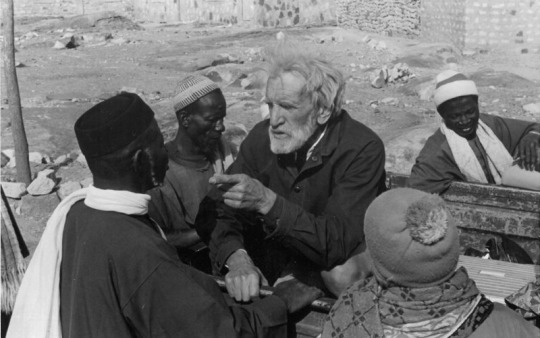
Herman Haan among the Dogon. | Source via Partners Pays-Dogon
As an architect he was one of the incidental participants of the Team 10 family and he brought Aldo van Eyck into contact with the Dogon people. He was also one of the Team 10 members that attended the famous CIAM meeting in Otterlo (NL) in 1959, that caused CIAM to break up definitely. His work consists mainly of private houses. It is very much within the post-war, modernist tradition of Team 10, but with a special open brutality and a humanist twist. He was one of the first modern architects that re-used building materials in his designs.



Herman Haan’s house in Rotterdam, 1951-53. | Photo by Violette Cornelius
Haan build the radically open house for himself and his wife Hansje on a piece of land at the edge of Rotterdam, where the debris of the demolished city centre during a bombardment in 1940 was collected. It consists of two elongated volumes: an elevated, floating open volume with the living room above and a small architect’s studio underneath half of this volume, and a second, closed volume with garage and two small bedrooms. In-between is a double height open space that connects both volumes as an entrance lobby.
The main feature of the living room volume is the set of four glass sliding doors, that can all be opened at the same time, thus literally opening the living room to the outdoors and the view over one of the main entrance roads of the city (and Haan did not believe in the use of curtains either). Another feature is the open kitchen, if not one of the first in architecture, then certainly of one the most radical open kitchens ever. It consists of a simple, small cooking table with a floating kitchen sink that stands in the middle of the living room and is connected to the open fire chimney only. Cooking is a social activity, so Haan had learned in Africa.
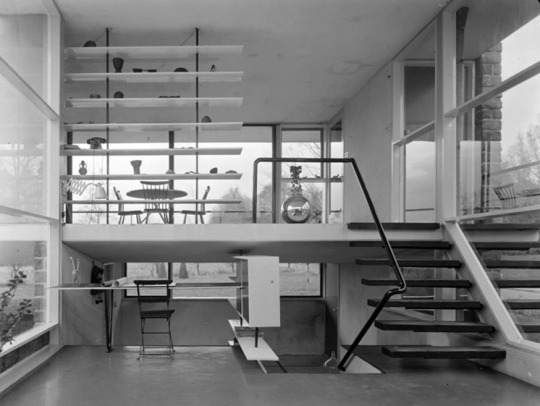
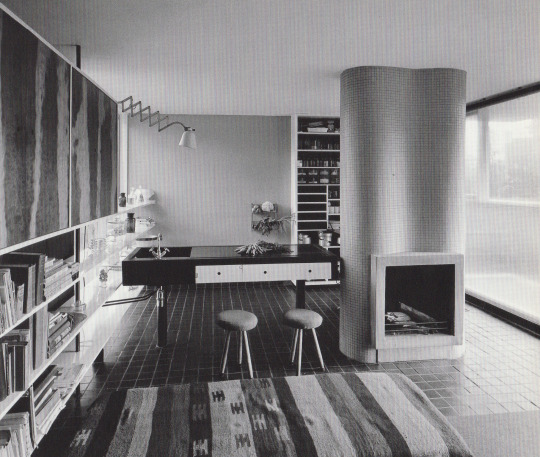
Open space and open kitchen. | Photo by Violette Cornelius
The bricks of the closed bedroom volume used in the interior are re-used pavement bricks from the quays of the Rotterdam harbor. An old poplar tree that stood on the site was cut into veneer and used as a finishing layer of cupboards all around the house. Parts of the stone flooring was salvaged from the rubble heap on which the house is build. The house is still standing, but the radical openness proved to be too much for the current owners. It is today surrounded by a wall of conifers, and parts of the glass facades are closed off.


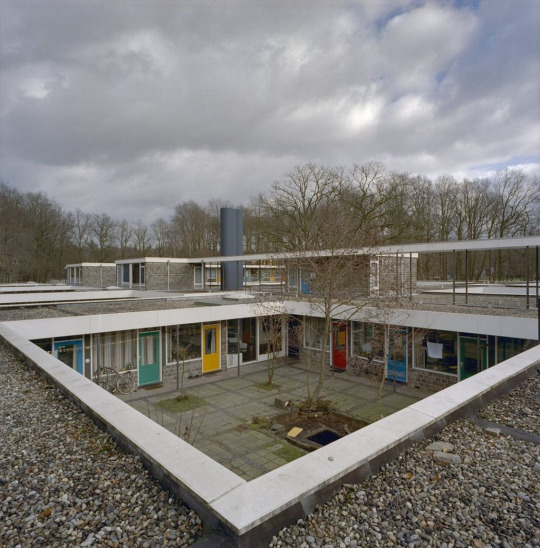
Patio Student Housing, Drienerlo Enschede, 1964-65. | Source Rijksdient voor het Cultureel Erfgoed
Herman Haan was asked by his mentor Willem Van Tijen (a first generation functionalist modernist) to build a batch of student housing for the campus of a new technical university in Enschede. It is unquestionably his most African project. The concept was based on the Matmata cave dwellings of southern Tunesia, famous for being the home of Luke Skywalker in Star Wars IV. It is also his most structuralist design, a so called mat-building based on a continuous square configuration, that was also one of the Team 10 tropes. The design consists of seventeen square units, joined in a larger configuration. Each unit consists of a patio with student rooms on two sides. Eight students live in such a patio unit (six one-person rooms, one two-person). Access to the rooms is from the patio, so each student room has his own front-door. Access to these patio’s themselves is mainly from the roof of the one - storey complex. A foot-path and bicycle road crosses the roof of the complex. The roof itself was one of the first green roofs in the Netherlands, sowed in with grasses. In the middle of the complex a larger central square and pool serves as a meeting place for the student community. The same pavement bricks from the quays of Rotterdam harbor, that he used in his own house and other projects, were used extensively in this one too. The project was recently fully restored and established as a National Monument of post-war architecture.

Frank van Klingeren selling his open architecture. | Source via Nieuwlanderfgoed
Frank van Klingeren (1919-1999), a Provo in a business suit was, unlike Herman Haan, a real outsider in the Dutch architecture scene of the 1960’s and 1970’s. Trained as a construction engineer, he was a self-taught architect that kept away from architecture gatherings or cliques. He was more at home among people from avant-garde theatre of the period, than among ‘Forum’ architects like Van Eyck, Bakema and Hertzberger, although he shared a lot of his ideas with the latter. They even received the Fritz-Schumacher-Preis in 1974 together, Hertzberger for his Centraal Beheer office in Apeldoorn, and Van Klingeren for ‘t Karregat in Eindhoven. Both buildings celebrating multi-functionality and an openness towards change.
Although Van Klingeren was quite productive as an architect from the late ‘50’s to the mid ‘70’s, his main claim to fame was established with the design of three consecutive multi-cultural community buildings or Agora as he called them; De Meerpaal in Dronten, Agora in Lelystad and ‘t Karregat in Eindhoven. But his media presence was broader than that. Especially after finishing De Meerpaal, he evolved towards a counterculture societal critic and television personality, while keeping his distance from direct involvement in flower power, hippie or provo movements. He was in that sense a Provo(cateur) in a business suit.


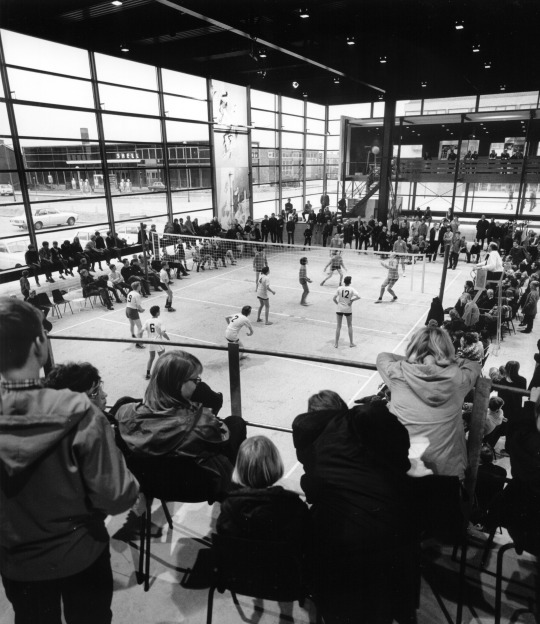

De Meerpaal, Dronten, 1965-1967 | Photo by Jan Versnel
Asked for a simple multipurpose community building with provisions for amateur theatre and music, sports and a small café for new inhabitants of the pioneer-village Dronten that was being built in the new polder Flevoland, Van Klingeren did much more than that, and in a sense also much less. He gave more space, more functionalities and more possibilities, but less stuff (walls, floors) and in a way less architecture. Van Klingeren was inspired by the village squares or agora of the Mediterranean that functioned as meeting places, open-air theaters and playground, while showing a generic, in fact absent, architecture. In this sense his agora can be seen as a sort of architectural urbanism.
De Meerpaal is in fact nothing more than a covered village square, protected from the northern climate by glass walls. It is a large glass-and-steel box measuring 50x70 meters with a couple of smaller brick boxes (some art and exhibition rooms, a tilted box with restaurant/ café, and a small staff office) added along the edges. In the middle of the covered space an oval open-air theatre - soon dubbed ‘The Egg’ - is the main architectural gesture. There are hardly any walls inside, neither are there many spaces for any specific function. All functions mix, sometimes causing hindrance. According to Van Klingeren, hindrance leads to conversation and mutual understanding. De Meerpaal was used for many different functions; the weekly market, agricultural exhibitions, sports, parties, large scale meetings etcetera. The oval theatre with its central stage (the setting of audience and use could be changed easily, anything was possible except a traditional proscenium set-up), became a place where alternative theatre groups loved to perform.
De Meerpaal was also the main stage for large size, live national television productions and games, until large-scale studios were built in Hilversum. Besides this television attention for Dronten, it was also equipped with a (rotating) film screen on which, besides normal movies, live television could be screened of the so-called Eidophor technique. Thus, the whole village could watch the news or football matches together from the indoor terrace of the café. De Meerpaal has, with some merit, been compared to Cedric Prices (unbuild) Fun Factory of the same time. But while Fun Factory can be called a machine for multi functionality, full of specific intentionality, De Meerpaal is more like a generic square where the intentionality of use and meeting is not outspoken, but nevertheless - maybe more so than in Fun Factory - more open to chance and unpredictable uses.


Agora Lelystad, 1966-1972 | Photo by Jan Versnel
While construction work for De Meerpaal was still going on, Van Klingeren was commissioned to design a similar multifunctional building for Lelystad, the second new town to be built in Flevoland. It was planned to become the largest city and capital of the new polder province. The first design elaborated further on the open concept and mix of functions of De Meerpaal. In this case the scale was larger and Van Klingeren managed to lure in the churches (three different denominations) into the collective. Although each church would have its own space, it was to be open like the open-air theatre and - as Van Klingeren argued - since these spaces would only be used on Sundays, they could double as extra theatre and meeting spaces for the rest of the week.
Meanwhile it was decided that not Lelystad but a newer town Almere to be built closer to Amsterdam would be more important and bigger, and construction of Lelystad was delayed. This meant that the scale and budget of Van Klingeren’s Lelystad Agora diminished too. Instead Van Klingeren proposed the opposite; to enlarge the program with shops and housing facilities (hotel, boarding house), but to do this within the limited budget (to do more with less, was one of his favorite slogans). He proposed a U-shaped steel post-and-beam structure of three storeys, to be left open and to be colonized over time by the people and by entrepreneurs. The ground floor would still be like De Meerpaal, only a swimming pool was added. This open ground floor would be connected to the adjoining park so that Van Klingeren started to title the different zones in the lay-out as if they were landscapes: theatre landscape, youth-cave, swimming and undressing landscape. All in an open ‘wall-less’ setting. While De Meerpaal could be called urbanism (realised with architectural means), this last design for Lelystad would have been a landscape design instead, growing over time. The proposal proved to be too radical for Lelystad and a toned down. Conventional Agora was built in the city centre by one of Van Klingeren former employees.

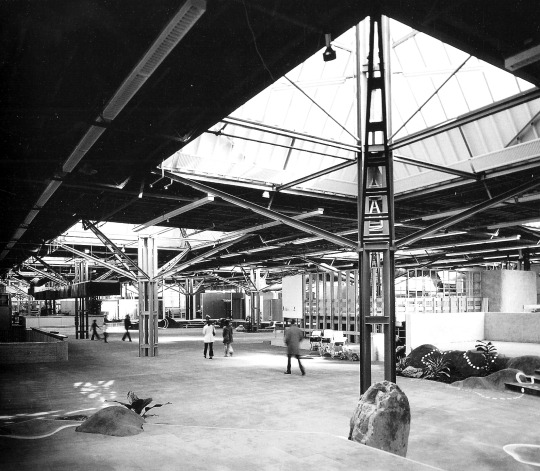

‘t Karregat Eindhoven, 1970-1973 | Photo by Jan Versnel
Van Klingerens attention had already shifted towards Eindhoven. There he was given the opportunity to build another multifunctional community building for a new experimental housing project. This time it would include – besides the cultural and sports facilities – a small shopping mall (bakery, greengrocer, a small supermarket) and a health facility with general practice (the café serving as a waiting room) and a pharmacy. But the real experiment was the inclusion of two elementary schools and a nursery school. These too would be built without any internal walls to speak of, one organic whole with the rest of the spaces and facilities, a field of communal activity. Children, according to Van Klingeren, would learn their arithmetic next to the supermarket cash desk, mothers could meet each other at the café bar after bringing their kids to school.
The one storey building (or rather the enclosed and climate controlled landscape) is situated underneath a flat roof with an open steel structure, that is supported by steel umbrellas; pyramid shaped skylights on open steel columns. All services (air-conditioning, electricity, rainwater drainage and ventilation) are positioned in sight within the steel roof structure, and can be accessed (and changed when the floor configuration is changed) from below. The perimeter facade is built-up out of off-the-rack components (mainly from the glass-house industry). In general, there is a certain high-tech feel to the architecture, albeit with the informal sloppiness of a self-built community house. Named ‘t Karregat (cart-sink after the shopping carts that would gather there) it was opened in 1973 without hardly any change in the original concept. After a couple of years, the schools without walls proved to be too much for the teachers, that went into the experiment without any primary experience whatsoever in new schooling methods. Glass partitions were applied, but besides that the openness was maintained and ‘t Karregat became an overnight success, also because the community ran the cultural facilities for themselves.
Afterlife
Both De Meerpaal and ‘t Karregat were highly successful until the 1990’s. When De Meerpaal, formerly publicly owned, was privatized in the 1980’s the open space was divided into smaller areas, and finally plans were made to demolish it around the year 2000. Protests from the architecture community and the State Architect managed to save the structure, especially the roof and The Egg. But several theatre spaces and a public library (all very much enclosed) were added so that the new Meerpaal can hardly be called open anymore, at least not in the sense that it was open in the 1960’s, both architecturally and functionally. More or less the same fate came over ‘t Karregat. After a successful period of a couple of decades, plans for demolishment were halted, and it is now restored; but a smooth false ceiling has killed the informal sloppiness of the original, partition walls have been added, patios are cut into the roof. Operation succeeded, patient died.
One may wonder whether this open architecture of De Meerpaal and ‘t Karregat was not so much geared towards it’s own time, and so much part of the open society, that it failed to be open towards societal change in the 1990’s. It very well may be the case, but then so is the architecture of the renewal. One of the protesting architects against demolishing De Meerpaal, Kas Oosterhuis, proposed to wrap the building up in plastic and to wait until society and technology would have been advanced towards a new phase fitting the original intentions of De Meerpaal. This would actually have been a great solution, and one has the feeling that now, only fifteen years after, the new Meerpaal feels old, and the old Meerpaal would fit much better in our current times, which are media driven, semi-virtual, but also with a longing for the open society of 50 years ago. The plastic could have been wrapped of already.
---
#FOMA 9: Piet Vollaard

Piet Vollaard is an architect and architectural critic working in Rotterdam. Besides monographs on both featured architects; ‘Herman Haan, architect’, Rotterdam (1995) and ‘Hinder en ontklonteren, architectuur en maatschappij in het werk van Frank van Klingeren’ with Marina van den Bergen, Rotterdam (2003), his publications include several Architectural guides to the Netherlands with Paul Groenendijk, Smart Architecture with Jacques Vink and Ed van Hinte, Rotterdam (2003); Positions, six Dutch architecture photographers with Simon Franke and Allard Jolles, Rotterdam (2010); Making Urban Nature with Jacques Vink and Niels de Zwarte, Rotterdam (2017), on nature-inclusive design in an urban context. He was founder and editor in chief of ArchiNed (1996-2013), and visiting teacher at several architecture schools in the Netherlands. His current activities focus on urban nature in a designer and ecologists collective The Natural City, and Stad in de Maak / City in the Making a collective of architects, designers and artists working in the field of commoning and activating empty buildings and related urban activism.
325 notes
·
View notes
Photo

Low rider don't use no gas now
Low rider don't drive too fast
Parents Magazine November 1953
#native american#vintage ads#advertising#advertisment#christmas ad#christmas#bicycle#vintage bicycle#vintage toys#1953#christmas gifts#children#1950s#1950s ad#1950's#1950's ad#funny#humor#humour#vintage ad
35 notes
·
View notes
Text
Leading to Lorna Simpson
Research Proposal
“Language is powerful. By using texts as the central communication vehicle in their artistic expression, artists push forth letters, numbers, and words as their primary means to get out the message” (Stewart, 2017). How have words impacted the art of Lorna Simpson? Words in art form started with medieval manuscripts with elaborate pictures. An example of this is the Palermo Stone. It has information written on it about the first five dynasties of Egypt.

Palermo Stone (c. 3150-c.2323 BCE) 43.5 cm high, 25 cm wide and 6.5 cm thick
en.wikipedia.org/wiki/Palermo_Stone
Marcel Duchamp
Marcel Duchamp is the French painter and sculptor (7-28-1887 to 10-2-1968) known for helping to move forward the ideas of conceptual art. He challenged the idea of, What is Art? Duchamp enjoyed using wordplay, especially puns, conveying visually. “The linguistic dimension of his work in particular paved the way for Conceptual Art.” Duchamp studied for one year at Paris’s Ecole les Beaux Arts and never returned.
Below is a link to Anemic Cinema: Duchamp’s video shows a spiral design spinning, alternating with puns in French.
https://youtu.be/dXINTf8kXCc
Duchamp took his inspiration from Cubism and minimalism but added more to his work. He added motion to a Cubist idea and a bicycle wheel to a stool which became the first readymade art.
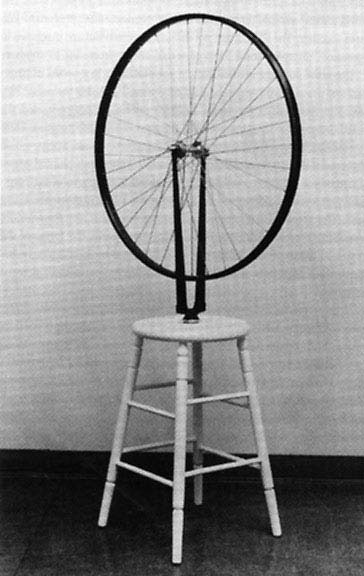
Bicycle Wheel. Marcel Duchamp.1951. Metal wheel mounted on painted wood stool, 51 x 25 x 16 1/2" (129.5 x 63.5 x 41.9 cm)
http://web.mnstate.edu/gracyk/courses/phil%20of%20art/duchamp2.htm
Conceptual Art
Conceptual Art is the movement from the mid 1960′s to mid 70′s, having many forms such as happenings, performances, and ephemera. Art is usually judged on aesthetics, expressions, and skill, but conceptual artists reject these normal standards of art. Conceptual Art is linked by work from Marcel Duchamp and influenced by minimalism. Not needing to look like a traditional piece of art or even take on a physical form. These artists have created art that is about art and pushed the limits by using little material and including text.
Erased de Kooning drawing (1953)

Robert Rauschenberg. Erased de Kooning Drawing. 1953. Charcoal, pencil, crayon, and ink drawing by Willem de kooning, erased. San Francisco Museum of Modern Art. sfmoma.org/artwork/98.298/
Jenny Holzer
Jenny Holzer was born in Gallipolis, Ohio in 1950. Holzer has a BA from Ohio University in Athens; a MFA from Rhode Island School of Design, Providence, and honorary doctorates from the University of Ohio, R.I. School of Design, and the New School University in New York. She was the first woman to represent the United States in the Venice Biennale in 1990. She lives and works in Hoosick Falls, New York.

Jenny Holzer. Survival series. 1983-85. Aluminum with varnish. 6.5 by 25.5 cm
The plaque is shown in the same way as a museum plaque. This style of displaying text is featured prominently in Jenny Holzer’s work. Holzer’s use of language, location, and focusing on social issues clearly impacted the work of Lorna Simpson.
Lorna Simpson
Lorna Simpson was born in Brooklyn, New York on August 13, 1960. She has a B.F.A. degree in photography from the School of Visual Arts in N.Y.C. and a M.F.A. degree in visual arts from the University of California, San Diego. Her first solo exhibit was in 1986 at Just Above Midtown Gallery in New York. She has since been an artist in residence in Massachusetts and Ohio, has had many exhibits in museums around the world, created films, and has work included in collections at the Museum of Modern Art, the Museum of Contemporary Art, and the Whitney Museum of American Art among others. Simpson first started doing documentary type photos, then moved on to graphic design. A friend urged her to California for grad school and there she was drawn to conceptual based art and language. Her early photos have models staged with text from newspapers and magazines. The words usually relating to racism, inequality of African Americans, and women. In the 1990′s, Simpson was one of the first African American woman to be in the Venice Biennale. Simpson is married with one child living in Brooklyn, New York.
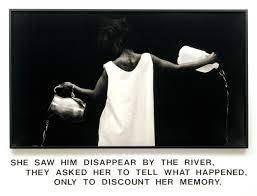
Lorna Simpson, The Water Bearer. 1986. Gelatin Silver Print with Vinyl Lettering
Although there is missing times in the evolution of artwork with text, the passage of time and the willingness of artist to broaden the horizons of what is considered art, has led Lorna Simpson to create the work she is famous for.
Works Cited
art21.org. Jenny Holzer. art21.org/artist/jenny-holzer/ Internet. Accessed 20 Apr 2021.
7 Oldest Known Writing in the World. www.oldest.org/artliterature/writing/ Accessed 20 Apr. 2021.
"Conceptual Art Movement Overview and Analysis". [Internet]. 2021. TheArtStory.org
Content compiled and written by Justin Wolf
https://www.theartstory.org/movement/conceptual-art/
First published on 01 Oct 2012. Updated and modified regularly
Accessed 20 Apr 2021
Hill, Jenny. “Palermo Stone.” Ancient Egypt Online. ancientegyptonline.co.uk/palermostone/ Accessed 20 Apr. 2021.
Hurst, Kris K. “Biography of Marcel Duchamp, Revolutionary of the Art World.” ThoughtCo. Feb. 5 2020. thoughtco.com/marcel-duchamp-biography-4173366 Accessed 20 Apr 2021.
"Jenny Holzer Artist Overview and Analysis". [Internet]. 2021. TheArtStory.org
Content compiled and written by Jen Glennon
Edited and revised, with Summary and Accomplishments added by Ruth Epstein
Available from: https://www.theartstory.org/artist/holzer-jenny/
First published on 22 Feb 2016. Updated and modified regularly
Accessed 21 Apr 2021
"Lorna Simpson Artist Overview and Analysis". [Internet]. 2021. TheArtStory.org
Content compiled and written by Rosie Lesso
Edited and revised, with Summary and Accomplishments added by Kimberly Cooper
Available from: https://www.theartstory.org/artist/simpson-lorna/
First published on 19 Nov 2020. Updated and modified regularly
Accessed 21 Apr 2021
"Marcel Duchamp Artist Overview and Analysis". [Internet]. 2021. TheArtStory.org
Content compiled and written by The Art Story Contributors.
https://www.theartstory.org/artist/duchamp-marcel/
First published on 21 Nov 2011. Updated and modified regularly
Accessed 20 Apr 2021
Rockefeller, Hall W. "The Life and Art of Jenny Holzer, Artist of Text-Based Truisms." ThoughtCo, Aug. 28, 2020, thoughtco.com/jenny-holzer-art-biography-4176548. Accessed 19 April 2021.
Stewart, Jessica. “8 Artists Who Use the Power of language in Art.” My Modern Met. June 2017. mymodernment.com/text-art-masters/ Accessed 20 Apr. 2021.
1 note
·
View note
Text
Cutting Edge Enabling Technologies for 2017
Only eleven days to go until the 11th WT|Wearable Technologies Meeting 2017 EUROPE. The leading profession fair for wearable and linked devices will certainly be taking area in Munich ´ s ICM International Congress Center and also will combine sector and innovation experts from around the world. This year, the meeting will certainly focus on wearable tools as well as boosting day-to-day experiences, from locations such as medication, sports as well as way of life. Numerous added uniqueness as well as advancements, consisting of the WT Technology Globe Cup victors, could be seen at WT|Wearable Technologies Conference 2017 EUROPE. Allow us present you to a few of our exhibitors in the group "Cutting-edge Enabling Technology".
Cicor
The Cicor Group is a globally energetic companion in the electronic devices sector. 1950 workers at ten manufacturing websites around the world provide a broad variety of innovation for the manufacture of complex PCBs as well as hybrids along with complete engineering as well as manufacturing services for electronics as well as plastics. Cicor Team offers total outsourcing solutions as well as a wide variety of innovative innovations, digital manufacturing services as well as a large range of production options from PCB assembly, system assembly, box-building, toolmaking and also plastic shot molding. We are an electronics provider with an international structure and also a wide array of production abilities in published motherboard setting up, system assembly and box building, control closet construction, cable television assembly and in the areas of toolmaking and also plastic injection molding.
Covestro
With 2015 sales of EUR 12.1 billion, Covestro is among the world's biggest polymer companies. Organisation tasks are concentrated on the manufacture of modern polymer materials and also the development of cutting-edge remedies for products made use of in many areas of day-to-day live. The main sectors served are the automotive, electrical as well as electronics, building and also sports and also leisure markets. Covestro products as well as the products made from them enhance our lives and also make the globe a brighter place. Whether as insulation for residences or the refrigerators inside them, in cushions, vehicle headlights and arena roofs, as protective layers or exceptionally thin films: Covestro's products advertise effectiveness, security as well as comfort in various locations of applications. The scheme includes polycarbonate - the crystal-clear as well as formable high-performance plastic that is at the same time very strong, lightweight as well as durable.
VTT
VTT Technical Research study Centre of Finland Ltd is the leading research and innovation business in the Nordic countries. They provide an overview on the capacity of high-volume printing modern technologies for sensors in Health care and Wearable Technology applications based upon instances of existing R&D work in Printed and Crossbreed Electronics at VTT. VTT's roll-to-roll pilot printing and also crossbreed assimilation centers provide upscaling framework for printed as well as hybrid gadgets in all product stages: from model to mass item. Their multidisciplinary specialists work together to aid our clients and also companions create brand-new products, production processes, techniques, and services. In doing so, we help advertise sustainable development, employment and wellness. Our broad network of co-operators indicates our clients obtain access to the most effective expertise worldwide.
Fraunhofer IIS
Founded in 1985, Fraunhofer Institute for Integrated Circuits IIS ranks initially among the Fraunhofer Institutes worrying headcount and also profits. The Institute supplies study as well as development solutions in different areas, such as IC Layout, Sound and Multimedia, Imaging Systems, Medical Modern technology as well as Wearable Sensors. The Fraunhofer Institute for Integrated Circuits IIS is among the world's leading application-oriented study establishments for microelectronic and also IT system remedies and also solutions. With the production of mp3 and also the co-development of AAC, Fraunhofer IIS has actually gotten to globally acknowledgment. Concerning 950 workers carry out agreement research study for sector, the solution market and public authorities.
CSEM
CSEM is a research study and development center focusing on microtechnology, nanotechnology, microelectronics, system engineering, photovoltaics and also interactions innovations. 450 very certified and specialized staff members from numerous scientific as well as technological techniques work for CSEM in Switzerland. Managing and also cultivating advancement to convert groundbreaking basic research study into innovative procedures, resulting in innovative items as well as assisting market and also society get ready for the future. They develop and maintain innovation systems, we integrate as well as combine innovations into workable systems, we grow those innovations until utilizing them will add worth to our commercial clients, after that we support the procedure of moving those innovations to industry.
Magnes
Magnes Styx is a wearable powermeter for road cycling which incorporates the sensors, electronic devices, as well as power system in the cleat permitting a remarkable user experience as well as very easy transfer in between bikes. With straight 3D force and power measurements on both legs, we are offering a brand-new method for efficiency monitoring with extraordinary biking analytics. It is placed on the cycling footwear and provides the most sophisticated biking power dimensions with the multi-point 3-axis pressure dimension system on both feet. You can take advantage of the opportunity to check your efficiency without any type of setup on your bicycle. It connects cordless with a conventional bike computer system or with a mobile phone via our personalized Magnes application or with your preferred cycling apps.
On 7th as well as 8th of February 2017 our exhibitors will cover a wide variety of different topics which we will certainly offer in our next couple of write-ups. Furthermore, all victors of the Development World Cup will certainly exist at the Advancement Wild Fire Session on the initial day of the conference (February 7., 3:40 pm). We wish to see you in Munich.
3 notes
·
View notes